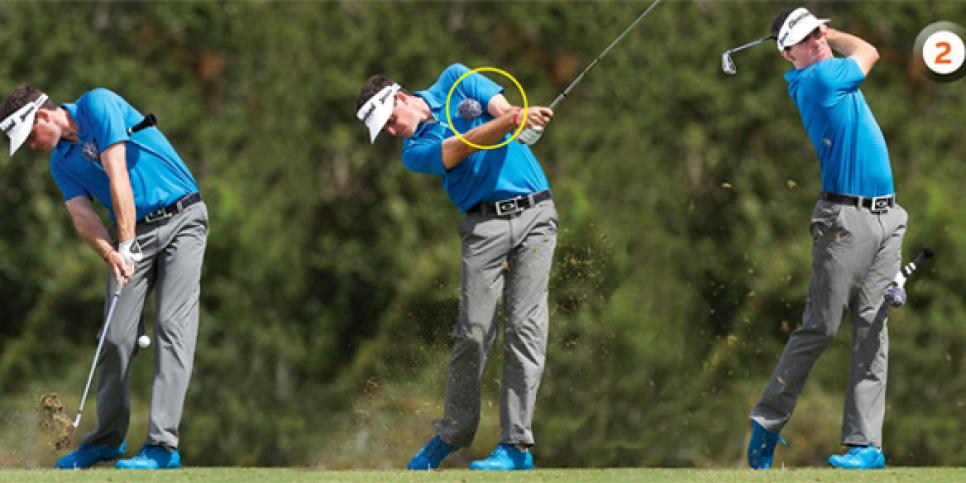Short Game
6 Keys To Solid Strikes

EDITOR'S NOTE: Two incredible iron shots. Of course, it took more than that for Keegan Bradley to go from 25-year-old up-and-comer on the PGA Tour to major champion. But the two approaches he hit in the three-hole playoff at the PGA Championship in August, which he won over Jason Dufner, are why we've asked Bradley to share his thoughts on iron play. "It's always been the strength of my game," he says. On the first playoff hole, after Dufner nearly holed his approach, Bradley answered by hitting an 8-iron to four feet and making birdie. Then, on the final hole, with a two-shot lead and facing a carry over water to a front pin, Bradley could have bailed out and played for the back of the green. Instead, he hit a 6-iron from 197 yards that just cleared the lake and wound up 18 feet from the hole. That swing secured his first major victory. "I hit the shot on 18 and took a sip out of my water bottle, and my hand is literally going like this, shaking, violently. There was so much adrenaline." We can relate to the nerves, but you're about to learn how he flushed that shot, like he does so many of his irons.

MY IRON KEYS
Seems like my iron play gets a little better every year. Which makes sense—I've been working hard on things with my teacher, Jim McLean. The advice he gives me is a big reason I'm progressing, but it's also confidence. I believe that hitting good iron shots comes from commitment. You can't swing with hesitation; you can't try to steer the ball to the flag; you can't worry about that water hazard as you take the club back. You have to pick the right club, visualize the shot you want to hit, and then focus on that shot until the ball is gone. Here I'm going to give you some swing advice, starting with my favorite drill (above and left), but in the end you have to believe in your swing. And don't pull the trigger until you're committed.

MASTER DRILL
Jim and I have spent a lot of time working on my swing path, which used to be so far inside on the backswing that I had to loop it to the outside coming down. Now I'm swinging the club back and down on a path that stays inside my target line everywhere but at impact (when it's directly on the line).
To ingrain an inside-to-inside swing path, which is ideal for power and control, Jim has me stuff a headcover under my left armpit (1) and try to keep it there as long as I can during the swing. It'll drop eventually but not until well after impact__ (2)__. In addition to improving your path, this drill gives you a great feeling of unity with your club, hands, arms and body as you swing. Everything must move in sync, or the headcover drops.

ADDRESS AND BACKSWING
It's very difficult to consistently hit good iron shots if you get off to a bad start. That's why I'm always paying attention to my setup and takeaway. An effective setup is more than just getting in good posture and lining up. It's also about ball position, and that seems to be the one thing amateurs I play with don't think about. They're usually not consistent with their ball position, and it varies from too far forward to too far back. To hit iron shots on a consistent trajectory and allow the club's true loft to control my distance, I never want the ball any farther back than center of my stance, and it's usually a touch forward. Check your ball position by dangling a club from the left side of your chest, just left of your shirt buttons (1). You want the ball to be directly below that.
Once you're ready to swing, make sure everything moves back together. I mentioned earlier that my club path used to go quickly to the inside and then loop to the outside on the way down. To keep the club on a good path, I'm constantly trying to start everything back in one piece__(2)__. I see a lot of amateurs flipping the club inside with too much hand action. Let your arms and body move the club back; don't control it with your hands. Initially, they should remain passive.

DOWNSWING AND FOLLOW-THROUGH
Once you reach the top and you're ready to start down, you don't want to think about anything—at least I don't. So you have to prepare for it ahead of time. If you take the club back to parallel, your clubshaft should be pointing left of your target, on a line parallel to your target line (3). If it isn't, you're going to have to make an adjustment on the downswing to strike it solid. It's easier to be consistent if you're in a good position at the top. The drill above will help you monitor your positions.
I know I just said I don't think of anything on the downswing, but I do want you to have one thought: Swing hard. I really mean that. Try to hit the ball as hard as you can without losing your balance__(4)__. Most amateurs are so worried about mis-hitting the shot or hitting it off line, they don't make an aggressive move. You'd be surprised how much better your swing will get if you let your natural athletic ability shine. So go after it.
My final thought: Consider three-quarter shots. I don't mean three-quarter speed. Grip down, stand a little closer to the ball, and focus on making a three-quarter finish. Keep your right foot down as long as you can and abbreviate your arm swing__(5)__. Feel as if you're holding off the clubhead release. Whenever I'm out of sync, hitting three-quarter shots helps me get my timing back.